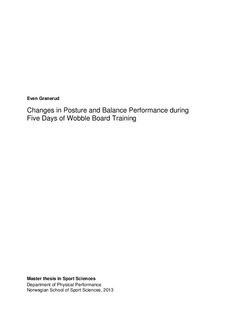| dc.description.abstract | Introduction: Human postural control is facilitated through postural movements such as
ankle-, hip-, or multi-joint strategies. Principal component analysis (PCA) applied to
kinematic marker offers a novel approach study the structure of postural movements by
identifying and quantifying correlated segment motion. This study investigated if the structure
of the postural movements changes as subjects learn to master a balance task (standing on a
wobble board). It was hypothesized that the relative contribution of principal components
quantifying the main types of body sway (e.g. ankle strategy) to the whole postural
movements would decrease as subjects improved in performance, while the contribution of
higher-order movement components would increase. Methods: Eleven healthy male
volunteers (age 25.1±1.7, weight 77.2±5.8 kg, height 1.80m±0.07) conducted a total of 25
120-second quiet stance trials on a wobble board, 5 trials per day during 5 consecutive days.
The subjects’ postural movements were recorded with a standard 3D-camera system
(ProReflex, Qualisys INC., Gothenburg, Sweden) using 49 reflective markers distributed over
all major body segments. For each timeframe, a 147-dimensional posture vector was defined
that included all marker coordinates. The posture vectors of all trials of a subject were
normalized and assembled into an input matrix for the PCA. The structure of a subject’s
postural movements was then characterized by calculating the relative contribution (RC) of
the first 10 principal movement components (PCs) to the entire postural variation in one trial.
For each trial, a “balance score” was calculated by totalling the standard deviation of the
vertical position of 4 markers placed on the wobble board. A repeated measures ANOVA
(Sidak correction) was conducted to determine differences in RC or balance score between
trials. Results: Balance performance on the wobble board improved over the first 2-3 test
days with the balance score decreasing from 52.1±11.0 in the first trial to levels below
34.2±6.1 in all trials of the 4th and 5th day (mean±stdev). This change was significant
(F(1,24)=11.17, p<0.007). However, no systematic changes were observed in the structure of
the postural movements as quantified by the first 10 PCs: F(1,24)<1.42, p>0.98 in the RC
calculated for the first 10 PCs. Conclusion: The hypothesis was not confirmed. The results of
this study suggest that the improvement in performing the wobble-board balance task was not
related to changes in the structure or organization of postural movements as quantified by
PCA-RC. | nb_NO |
